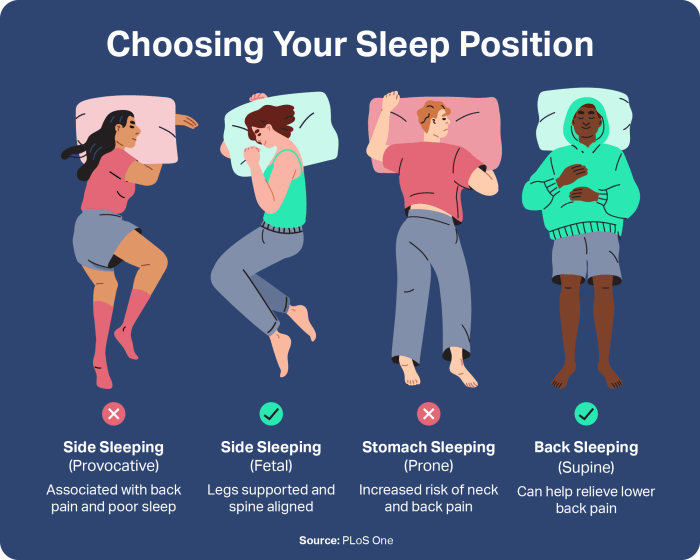Is sleeping on your stomach really that bad? This deep dive explores the potential physical and health implications of this popular sleep position. We’ll examine pressure points, sleep quality, and even cultural influences to understand if this seemingly comfortable position could be hindering your well-being. From aches and pains to potential posture problems, we’ll unpack the full picture of stomach sleeping.
The article will delve into the potential effects of stomach sleeping, including pressure on the spine, neck, and hips. We’ll also investigate how this position might affect breathing, sleep quality, and even the risk of snoring and digestive issues. The analysis will compare stomach sleeping to other positions like back and side sleeping, highlighting the potential benefits and drawbacks of each.
Physical Effects of Stomach Sleeping

Rolling over onto your stomach might feel cozy, but this sleep position can take a toll on your body. The unnatural alignment of your spine and the concentrated pressure on specific areas can lead to a range of discomfort and even long-term issues. Understanding these potential physical effects can help you choose a sleep position that promotes better rest and overall well-being.The pressure points and their impact on the body during stomach sleeping are often significant.
This position can lead to a misalignment of the spine and neck, contributing to pain and discomfort. Strain on the hips and shoulders is also a frequent concern, as these areas bear the brunt of the weight distribution. Common aches and pains associated with stomach sleeping are frequently reported, impacting sleep quality and daily activities.
Pressure Points and Their Effects
Understanding how weight distribution differs across various sleep positions provides insight into the potential physical effects of each. The concentrated pressure on certain parts of the body in stomach sleeping contrasts with the more evenly distributed weight in other positions, such as back or side sleeping. This disparity in pressure distribution can significantly affect the spine, neck, hips, and shoulders.
- Neck and Spine Strain: Sleeping on your stomach can put excessive pressure on the cervical spine (neck area) and the lumbar spine (lower back). This unnatural curvature can lead to stiffness, pain, and even long-term problems like spinal misalignment. Many individuals experience morning stiffness or pain in these areas after stomach sleeping for extended periods. For example, a person who consistently sleeps on their stomach might develop chronic neck pain over time.
- Hip and Shoulder Strain: The weight of the body is often concentrated on the hips and shoulders when sleeping on the stomach. This uneven pressure can lead to muscle strain, soreness, and even joint pain. The constant strain on these areas can contribute to discomfort, making it difficult to move or maintain a comfortable position throughout the night.
- Common Aches and Pains: Stiffness in the neck, back, and shoulders are common complaints among stomach sleepers. Furthermore, pain in the hips and lower back is also frequently reported. These aches and pains can be exacerbated by poor mattress support, improper pillow use, and maintaining the stomach sleeping position for prolonged durations.
Comparison of Pressure Distribution
The table below illustrates the potential pressure points across different sleep positions, highlighting the differences in weight distribution.
| Sleep Position | Pressure Points |
|---|---|
| Stomach | Neck, spine, hips, shoulders |
| Back | Spine, hips |
| Side | Shoulder, hip |
Breathing Impact
The position of the body during sleep can influence breathing patterns. When lying on the stomach, the chest and diaphragm may be compressed, potentially hindering deep and efficient breathing. This restricted breathing can lead to shallow breaths, impacting oxygen intake and sleep quality. For example, individuals with respiratory conditions may find that stomach sleeping exacerbates symptoms due to the reduced breathing capacity.
Health Implications
Sleeping on your stomach, while sometimes comfortable, can have several potential health consequences. Understanding these implications can help you choose a sleep position that best supports your well-being. From impacting sleep quality to potentially increasing the risk of musculoskeletal problems, the position we choose for rest can have a significant influence on our overall health.While some people find stomach sleeping comfortable, the position can restrict breathing and put pressure on the spine, potentially leading to discomfort and even long-term issues.
The following sections delve deeper into these potential health implications, providing a comprehensive understanding of how different sleeping positions affect our physical and overall well-being.
Impact on Sleep Quality
Stomach sleeping can often disrupt sleep patterns. The unnatural spinal alignment can lead to discomfort, making it harder to fall asleep and stay asleep. This can result in reduced sleep duration and a feeling of being unrested, which can have a cascading effect on daily activities and overall well-being. For example, individuals who consistently struggle to maintain a comfortable position during sleep may find themselves waking up frequently, leading to a less restorative sleep experience.
So, is sleeping on your stomach really that bad for your spine? While some say it can contribute to neck and back pain, it’s a bit of a complicated issue. Apparently, there’s a fascinating connection between sleep posture and weird marketing campaigns, like this one featuring a ramen ad with a samurai schoolgirl and a drone ramen ad samurai schoolgirl drone.
Perhaps the answer to whether stomach sleeping is bad lies not in the science, but in the sheer absurdity of some advertisements? Regardless, finding a comfortable sleep position is key for a good night’s rest.
Correlation with Snoring
The pressure exerted on the airway during stomach sleeping can potentially restrict breathing, leading to snoring. This is because the position can obstruct the airways, making it harder for air to flow freely. For individuals already predisposed to snoring or sleep apnea, stomach sleeping can exacerbate the issue. This can affect the quality of sleep for the individual and those sharing the bed, due to the disruptive nature of snoring.
Connection with Digestive Issues
The pressure exerted on the abdomen during stomach sleeping can sometimes affect digestion. This pressure can potentially cause discomfort or even contribute to acid reflux in some individuals. This is particularly relevant for those with pre-existing digestive conditions. Furthermore, the position might impact the natural movement of digestive enzymes, potentially impacting the efficiency of the digestive process.
Musculoskeletal Problems
Stomach sleeping can increase the risk of developing musculoskeletal problems, such as back pain and neck pain. The unnatural spinal alignment can put strain on the muscles and joints, leading to pain and discomfort. Over time, this can contribute to chronic pain issues. In contrast, sleeping on your back or side, maintaining a more neutral spinal alignment, reduces this risk.
Effect on Posture
Maintaining a consistent stomach sleeping position over extended periods can potentially contribute to poor posture. The pressure and strain on the spine and neck can lead to postural imbalances, which might manifest as discomfort or even more significant musculoskeletal issues over time. This can also affect the alignment of other parts of the body, leading to a cascade of postural problems.
Comparison of Sleep Positions
| Sleep Position | Sleep Quality | Breathing | Musculoskeletal Impact |
|---|---|---|---|
| Stomach | Potentially worse due to discomfort and restricted breathing | Can be restricted, potentially leading to snoring | Increased risk of pain, particularly in the back and neck |
| Back | Generally good, providing a neutral spine alignment | Normal, unobstructed breathing | Lower risk of pain compared to stomach sleeping |
| Side | Generally good, with a more natural spinal alignment | Normal, unobstructed breathing | Lower risk of pain compared to stomach sleeping |
Cultural and Personal Factors: Is Sleeping On Your Stomach Really That Bad
Beyond the physical effects, our cultural backgrounds and personal preferences play a significant role in shaping our sleep positions. These factors often intertwine, influencing comfort levels and habits developed over time. While some positions might be linked to health concerns, the deeply ingrained nature of cultural and personal choices often overrides the potential risks.Our sleep positions are more than just a matter of physical comfort; they are intertwined with our cultural heritage, personal preferences, and past experiences.
This interplay of factors often leads to unique sleeping habits that can be quite varied from one person to the next and across different cultures. Understanding these influences helps us appreciate the complexity of our sleep patterns and recognize that a “bad” position may simply be a matter of individual or cultural norm.
Cultural Variations in Sleeping Positions
Different cultures have varying perspectives on sleeping positions. For instance, in some Asian cultures, sleeping on the back is considered respectful and associated with good health. Conversely, stomach sleeping might be more common in some Western cultures, often due to historical and societal influences. These variations highlight the profound cultural impact on sleep practices. Further, cultural norms often dictate not only the preferred position but also the accompanying rituals and beliefs surrounding sleep.
Personal Preferences and Comfort
Individual comfort is a crucial factor in sleep position selection. People gravitate towards positions that provide the most physical ease and relaxation. This personal preference is often shaped by body type, physical ailments, and even the type of bedding used. A person with back pain, for example, might favor side sleeping, while someone with a more flexible physique might find stomach sleeping more comfortable.
So, is sleeping on your stomach really that bad? While some studies suggest potential back pain, it’s not a universally harmful position. Interestingly, the intense scrutiny surrounding cases like the Julian Assange extradition to the US, UK, and potential charges related to WikiLeaks, espionage, and hacking here raises questions about the potential for physical and mental strain.
Ultimately, finding a comfortable sleep position, regardless of the side you choose, is key to a restful night’s sleep.
Childhood Habits and Their Influence
Early childhood experiences often play a significant role in shaping lifelong sleep habits. For example, if a child was frequently placed in a specific sleeping position as an infant, they may continue to adopt that position as an adult, regardless of its potential health implications. These deeply rooted habits, often formed unconsciously, can persist throughout life.
Age-Related Variations in Response to Stomach Sleeping
The impact of stomach sleeping can vary across different age groups. Young children, with their developing spines, might be more susceptible to the potential negative effects of prolonged stomach sleeping. Conversely, adults might experience these effects less acutely, depending on factors like pre-existing health conditions and lifestyle choices.
Factors Influencing Sleep Position Preferences
| Factor | Description | Impact on Sleeping Position |
|---|---|---|
| Personal Preference | Individual comfort and body type | Directly influences choice of position |
| Cultural Norms | Societal beliefs and traditions | Indirectly shapes sleeping habits |
| Childhood Habits | Early experiences and conditioning | Can create lasting impact on position |
| Comfort Level | Perceived ease and relaxation | Influences position choice based on perceived comfort |
Alternatives and Solutions
Relieving the physical strain of stomach sleeping requires a multifaceted approach. Simply changing positions isn’t always enough; often, adjustments to pillows, mattresses, and even personal habits are needed to find a truly comfortable and supportive sleep experience. This section delves into practical strategies to mitigate the negative effects of stomach sleeping and improve overall sleep quality.
Alternative Sleeping Positions
Different sleeping positions offer varying degrees of support and pressure relief. Recognizing these alternatives is crucial for finding a better fit for your body.
- Back sleeping is a popular choice for its potential to reduce back pain. Maintaining a neutral spine alignment is key, which can be achieved by placing a pillow beneath the knees to support the natural curve of the lower back.
- Side sleeping, often preferred by individuals experiencing shoulder or hip discomfort, can be optimized with strategic pillow placement. A pillow between the knees can help maintain proper spinal alignment and reduce pressure on the hips and shoulders.
- Combination positions like lying on your back and then gently rolling to your side can be a practical approach for those who find back or side sleeping uncomfortable. This gives the body a more balanced support and helps to prevent pressure points from forming in one specific area.
Strategies for Improving Stomach Sleeping Posture
Addressing posture when stomach sleeping is crucial for minimizing strain on the back, neck, and shoulders.
- Conscious awareness of spinal alignment during sleep is paramount. If you find yourself consistently arching your back, conscious effort to maintain a straighter posture can greatly improve comfort.
- Gradual adjustments are often more effective than drastic changes. Try slightly altering your position every few nights to gradually find a more comfortable and supportive posture.
- Practice good sleep hygiene, including a regular sleep schedule and a relaxing bedtime routine, can positively influence your sleep posture and overall sleep quality. This also aids in better sleep quality regardless of the sleeping position.
Supportive Pillows for Stomach Sleepers
Pillows play a vital role in alleviating pressure points and supporting proper spinal alignment.
- Body pillows are designed to support the entire body, providing significant pressure relief for stomach sleepers. They can help maintain spinal alignment and distribute weight evenly across the body.
- Wedge pillows are specifically designed to elevate the upper body, which can aid in breathing and reducing pressure on the neck and shoulders. Their effectiveness is especially noticeable for individuals with breathing issues.
- Contour pillows are shaped to conform to the natural curves of the body, providing targeted support for the neck and head. Their form-fitting design improves posture and prevents neck pain, which is a frequent concern for stomach sleepers.
Addressing Specific Pain Points
Understanding and addressing specific pain points related to stomach sleeping is crucial for personalized solutions.
- Neck pain can often be alleviated by using a supportive pillow that conforms to the natural curve of the neck. A contour pillow or a pillow with a higher loft may be beneficial in this situation.
- Back pain can be mitigated by maintaining proper spinal alignment. A pillow beneath the knees or a body pillow can help support the natural curve of the lower back.
- Shoulder pain may be reduced by using a wedge pillow to elevate the upper body, thereby decreasing the pressure on the shoulders. Alternating between sleeping positions can also help.
Adjusting the Mattress for Better Support
Choosing the right mattress plays a significant role in achieving a comfortable and supportive sleep experience.
So, is sleeping on your stomach really that bad for your spine? It’s a common question, and the answer isn’t always straightforward. While some sources suggest it can lead to neck and back pain, others argue it’s not inherently harmful. But if you’re looking for a hilariously distracting way to take your mind off potential sleep posture issues, check out the Big Mouth Billy Bass Alexa on Amazon, which can be a surprisingly effective sleep aid (or at least a conversation starter) – big mouth billy bass alexa amazon.
Ultimately, though, finding a comfortable sleeping position is key, regardless of the fun, quirky accessories you add to your room.
- Mattress firmness is a key factor. A mattress that’s too soft may not provide adequate support for stomach sleepers, potentially exacerbating back and neck pain. A medium-firm mattress is often recommended for better spinal alignment.
- Mattress height can also impact sleep posture. A higher mattress might provide more support for stomach sleepers. Consider this factor in addition to firmness.
- Mattress age can impact its ability to provide adequate support. A worn-out mattress may not offer the same level of support as a newer mattress. Replacing an old mattress could lead to better sleep quality.
Comparison of Supportive Pillow Types for Stomach Sleepers
| Pillow Type | Description | Effectiveness |
|---|---|---|
| Body Pillow | Supports the entire body, providing comprehensive pressure relief. | Good for pressure relief, improves spinal alignment. |
| Wedge Pillow | Elevates the upper body, promoting better breathing and reducing neck/shoulder strain. | Can improve breathing, reduces pressure on neck and shoulders. |
| Contour Pillow | Provides targeted support for the neck and head, conforming to the natural curves of the body. | Improves posture, prevents neck pain, and reduces pressure points. |
Illustrative Examples

Sleeping on your stomach, while seemingly comfortable for some, can lead to a range of physical issues. Understanding these scenarios can help you make informed choices about your sleep posture and overall well-being. By examining the consequences of poor posture and the benefits of good posture, you can gain a clearer perspective on the importance of proper body alignment during sleep.The following examples illustrate the impact of different sleep positions on the body and the positive effects of adopting a more beneficial posture.
Understanding these scenarios will help you appreciate the connection between sleep position, physical comfort, and overall health.
A Scenario of Stomach Sleeping Discomfort
A young adult, Sarah, frequently sleeps on her stomach. She often wakes up with a stiff neck, radiating pain to her shoulders and back. The pressure on her spine and the twisting of her neck throughout the night cause significant discomfort. Her symptoms worsen after prolonged periods of sleep. This scenario highlights the potential for neck and back pain associated with stomach sleeping.
Ideal Sleep Posture and its Benefits
The ideal sleep posture involves aligning the spine in a neutral position. This allows for proper distribution of weight, reducing stress on the spine and surrounding muscles. Sleeping on your back or side, with proper support, allows the spine to maintain its natural curves. This alignment promotes relaxation and prevents the buildup of pressure points, leading to better sleep quality and reducing morning stiffness.
Negative Effects of Poor Sleep Posture on Neck and Spine, Is sleeping on your stomach really that bad
Poor sleep posture, particularly stomach sleeping, can lead to chronic neck and back pain. The unnatural twisting of the spine and the uneven distribution of weight put excessive strain on the muscles, ligaments, and discs in the neck and spine. Over time, this can lead to stiffness, pain, and potential long-term musculoskeletal issues. Chronic pain can also affect daily activities and overall well-being.
Switching to a Different Position and Experiencing Improvement
After experiencing persistent neck pain, Mark decided to switch from stomach sleeping to sleeping on his side. He used a supportive pillow to maintain the natural curve of his neck and spine. Within a week, he noticed a significant reduction in neck pain and stiffness. This demonstrates how a simple change in sleep position can positively impact physical discomfort and improve overall sleep quality.
Importance of Proper Body Alignment During Sleep
Proper body alignment during sleep is crucial for maintaining spinal health and preventing pain. Maintaining the natural curves of the spine distributes weight evenly, reducing stress on the supporting structures. This prevents the development of chronic pain and promotes better sleep quality. A good mattress and appropriate pillows are essential components of proper body alignment.
A Supportive Mattress Designed for Various Sleep Positions
A memory foam mattress, designed with adjustable firmness levels, is an excellent choice for accommodating various sleep positions. Its conforming nature molds to the body’s contours, providing targeted support for different pressure points, regardless of the sleeping position. This feature is particularly beneficial for stomach sleepers, side sleepers, and back sleepers, promoting a more comfortable and restorative sleep experience.
It features zoned support, offering varying firmness levels for different parts of the body, further optimizing alignment and reducing pressure points. The breathable material ensures that the mattress remains cool and comfortable throughout the night, preventing overheating and maximizing sleep quality.
Summary
In conclusion, while stomach sleeping might seem harmless, this position can indeed lead to various physical and health issues. Understanding the pressure points, potential health implications, and alternative positions can help you make informed decisions about your sleep posture. Ultimately, prioritizing comfort, support, and proper body alignment during sleep is crucial for overall well-being. Consider adjusting your sleeping position, pillows, or mattress to mitigate potential discomfort and optimize your sleep experience.






